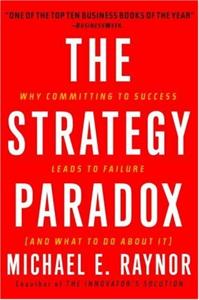
Want to learn the ideas in The Strategy Paradox better than ever? Read the world’s #1 book summary of The Strategy Paradox by Michael E. Raynor here.
Read a brief 1-Page Summary or watch video summaries curated by our expert team. Note: this book guide is not affiliated with or endorsed by the publisher or author, and we always encourage you to purchase and read the full book.
Video Summaries of The Strategy Paradox
We’ve scoured the Internet for the very best videos on The Strategy Paradox, from high-quality videos summaries to interviews or commentary by Michael E. Raynor.
1-Page Summary of The Strategy Paradox
What’s So Paradoxical About Strategy?
The future will probably not look the way we expect it to, but if you can predict what’s going to happen in a certain situation and act accordingly, you’ll be successful. However, there are specific conditions that must be met for your strategy to work. If those conditions change or even disappear, your strategy won’t work anymore.
To deal with the challenges of an uncertain future, managers need to be flexible. They can’t assume that things will definitely happen a certain way so they have to prepare for various possibilities. To do this, companies should use strategic flexibility and create plans which allow them to keep their options open. Then, they can layer risk management on top of these plans over time in order to handle uncertainty at different levels within the organization.
Planning Is Essential Even If Plans Are Useless
The failure of Sony’s Betamax was an unfortunate result of a strategy that involved taking too many risks, combined with bad luck. The safe road isn’t really safe because mediocre performance inevitably loses in the marketplace – it just loses more slowly than bad performance. Sony’s venture into Betamax technology wasn’t a blunder because Sony’s leaders didn’t make mistakes or act irresponsibly; instead, looking back at the situation from today, we can see how they made excellent choices given what they knew at the time.
However, there were a few problems with Betamax, so the company decided not to pursue it. When Sony realized that some unlikely events had actually occurred in their favor (i.e., VHS tapes could hold two hours of content and they didn’t have any competition), they made the decision to drop Betamax altogether.
Once Sony executives saw that people would be willing to trade quality for convenience, they responded quickly by creating a tape that could play two hours of uninterrupted movies. However, by the time their new product was ready for release, VHS had already won the video rental market. They didn’t make Betamax movies available to rent and lost out on the market because of it. Their decisions were reasonable but they failed to consider all possibilities. When they realized their mistakes, there wasn’t enough time or resources left to fix them in order compete with VHS.
Sony had a highly differentiated strategy. CEO Akio Morita worked with fewer than a half-dozen close associates, which might have limited his ability to consider all possibilities for the future. A more diverse view of Sony’s future might have helped him create strategies to deal with more varied possibilities. He could have anticipated losing the movie rental market by focusing on one type of product and left room for competitors to move in if they wanted to do so. In the end, “chalk up Betamax’s demise to the strategy paradox. Sony created exactly the kind of strategy required to succeed, but in so doing, created the possibility of total failure.”
Being Daring Can Lead to Victory and Failure
The most effective business strategies are also the ones that can fail the worst. This is because strategies work in particular conditions and require companies to commit to a single tactic, which limits flexibility. The more different the future is from what you assumed your strategy would be, the more likely it will fail.
Frontiers are the most profitable businesses. They have made long-term commitments and can’t be replicated by other companies in time to compete with them. Most organizations cluster around midrange strategic tradeoffs, which makes it harder for them to avoid failure. Customer preferences change quickly, so those changes constitute strategic uncertainty.






